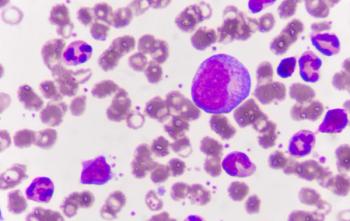
Trastuzumab Does Not Increase Cardiac Toxicity in Patients With HER2+ Breast Cancer
Trastuzumab (Herceptin) did not reduce cardiac function in women with node-positive, HER2-positive, early-stage breast cancer, according a study published in the Journal of Clinical Oncology.
A trial that assessed whether adding trastuzumab to standard paclitaxel after doxorubicin and cyclophosphamide (AC) chemotherapy would improve disease-free survival or overall survival (OS) in women with HER2-positive breast cancer showed that trastuzumab (Herceptin) did not reduce cardiac function in women with node-positive, early-stage breast cancer. These long-term follow-up (LTF) results, from the National Surgical Adjuvant Breast and Bowel Project (NSABP) B-31 trial, were published in the Journal of Clinical Oncology.
Investigators reported that both patients who received trastuzumab along with adjuvant chemotherapy and women who received chemotherapy alone maintained good cardiac function. Only 4.5% of patients from the control group and 3.4% from the trastuzumab group had a >10% decline in left ventricular ejection fraction (LVEF) from baseline to a value <50%.
“Breast cancer patients who received anthracycline and taxane-based chemotherapy with or without trastuzumab maintained excellent cardiac function a median of 8.8 years after treatment was started,” lead author Patricia A. Ganz, MD, director of Cancer Prevention and Control Research, UCLA Jonsson Comprehensive Cancer Center, said in a press release. “In addition, patient reports of greater cardiac symptoms indicated more cardiac problems in the small group who had difficulties. Overall, for the relatively young women who entered this trial, the risks of cardiac late effects were minimal.”
Planned combined efficacy joint analysis with the similar NCCTG (North Central Cancer Treatment Group) N9831 trial showed that trastuzumab was associated with a 10-year OS of 84% (HR, 0.63).
All patients received 4 cycles of 60/600 mg/m2 AC every 3 weeks followed by 175 mg/m2 of paclitaxel every 3 weeks for 4 cycles or 80 mg/m2 weekly for 12 weeks. Patients randomly assigned to the investigational group also received trastuzumab at 4 mg/kg concurrently with the first dose of paclitaxel followed by 2 mg/kg weekly for a total of 52 weeks.
A total of 128 patients in the control group and 313 in the experimental group agreed to participate in the long-term follow-up assessments of cardiac function, patient-reported outcomes (PROs) related to health-related quality of life (HR QoL), and cardiac-related symptoms and morbidity.
Investigators monitored cardiac function using LVEF measured by multigated acquisition (MUGA) scans at 3, 6, 9, and 18 months after random assignment. In the control group, 110 patients completed the MUGA scans and 98 completed HR QoL questionnaires compared with 297 and 268 in the trastuzumab group, respectively.
At 18 months, the mean decline from baseline was 3.2% in the control group and 3.9% in the trastuzumab group. At the LTF assessments, the mean decline from baseline was 3.9% versus 2.8%, respectively.
Three (2.7%) control group LTF participants had a reported decline of ≥10% to <50% at their 18-month assessment compared with 23 patients (7.7%) in the trastuzumab group. At the LTF assessment, 5 patients (4.5%) in the control group experienced a decline versus 10 (3.4%) in the trastuzumab group. One patient in the control group and 2 in the trastuzumab group with LVEF measurements >50% at 18 months had LTF measurements that declined to <40% at LTF.
Nearly 90% of LTF participants completed PRO surveys. The median time from random assignment to questionnaire completion was 8.7 years (range, 5.5-14). Investigators found high scores on the mental component scale (MCS) and physical component scale (PCS) of MOS-SF36 and the Duke Activity Status Index (DASI), “reflecting higher-than-expected physical and mental functioning compared with reference populations of the same age.”
The mean PCS score for all patients was 49.7 (SD, 9.1), and the mean MCS score was 52.9 (SD, 9.4). The mean DASI score was 45.6 (SD, 13.8; range, 7.2-58.2) for the total sample. Investigators said lower DASI scores were linked with age and use of certain medications, but did not correlate with the addition of trastuzumab.
“Our study improved the 10-year survival for women with this type of aggressive breast cancer to 84% and now our long-term follow-up of how these women are doing provides positive and encouraging data specifically about their cardiac function and health,” co-author Edward Romond, MD, professor, University of Kentucky Markey Cancer Center, said in a press release.
Ganz PA, Romond EH, Cecchini RS, et al. Long-term follow-up of cardiac function and quality of life for patients in NSABP protocol B-31/NRG Oncology: A randomized trial comparing the safety and efficacy of doxorubicin and cyclophosphamide (ac) followed by paclitaxel with AC followed by paclitaxel and trastuzumab in patients with node-positive breast cancer with tumors overexpressing human epidermal growth factor receptor 2. J Clin Oncol. 2017;35:3942-3948.
Newsletter
Knowledge is power. Don’t miss the most recent breakthroughs in cancer care.

















































































